The room is hushed, the atmosphere focused and intense, as students in a botanical illustration class at the Margaret Ferguson Greenhouses zero in on their project for the morning—accurately rendering a narcissus bulb.
That’s much harder than it sounds, as Sarah Roche, education director of the Friends of Wellesley College Botanic Gardens certificate in botanical art and illustration, will attest. These artists will come to know, and illustrate, their plant in every phase of its growth. They will measure it, contemplate it, rotate it to multiple angles. Their task, as Roche puts it, is to “draw what you really see, not what you think you see. When you draw it, you can’t make it up. It takes a lot of practice.”
Since 2003, the WCBG Friends has offered a range of botanical illustration classes, from the introductory Plants for the Petrified to color theory. Some students take a session or two and move on, but a growing number have taken on the demanding curriculum that leads to the certificate in botanical art and illustration, established in 2006.
‘This is not a quiet little thing done by Victorian ladies as an accomplishment. It’s recognized and collected as an art form all over the world. You have one foot in art and one foot in science.’
—Sarah Roche
The course of study, which was reviewed by the Wellesley College curriculum committee, takes three or more years to complete. It includes nine foundation courses such as plant biology and botanical art history; nine techniques courses, including drawing and watercolor painting; and two “accomplishments” courses, which include an independent study and a portfolio review. Five core faculty members and visiting instructors—from outside the College faculty—lead the classes. The first certificates were awarded in 2010; as of this June, 15 artists have earned them. Roche illustrates each certificate herself.
“It is rigorous, and people get really into it,” says Roche. “You can’t show your artwork until you’ve taken all the coursework.”
Roche, who grew up in Great Britain, came to New England with her husband, who was transferred here, and their three daughters. She originally connected with the WCBG through Sandy Snow Adams ’59.
“Sandy was looking for someone to teach her botanical illustration, and we started a Friday morning class at the greenhouses. More and more people got involved, and we asked if we could have a program—not a Wellesley College program, but under the Wellesley umbrella and with a Wellesley feel to it,” she says.
The intensity of the program creates a camaraderie and mutual support among its graduates that is hard to leave behind, one reason a group of certificate holders got together to begin an ambitious project—creating a Wellesley florilegium to document the College’s precious botanical holdings. “It’s so exciting,” says Roche. “They want to continue to be part of this place, and leave a legacy.”
Florilegium: The word is from the Latin flos (flower) and legere (to gather), so the collection is literally a gathering of flowers. The first printed florilegia began to appear in the late 16th century. Unlike medieval herbals, which could be considered medical and culinary texts, florilegia usually contained minimal text, or even none except an index of the names of the plants in the volume. The illustrations aimed to accurately capture the color and characteristics of the flowers and trees represented. From the beginning, florilegia illustrations were meticulously drawn from nature—as they are today.
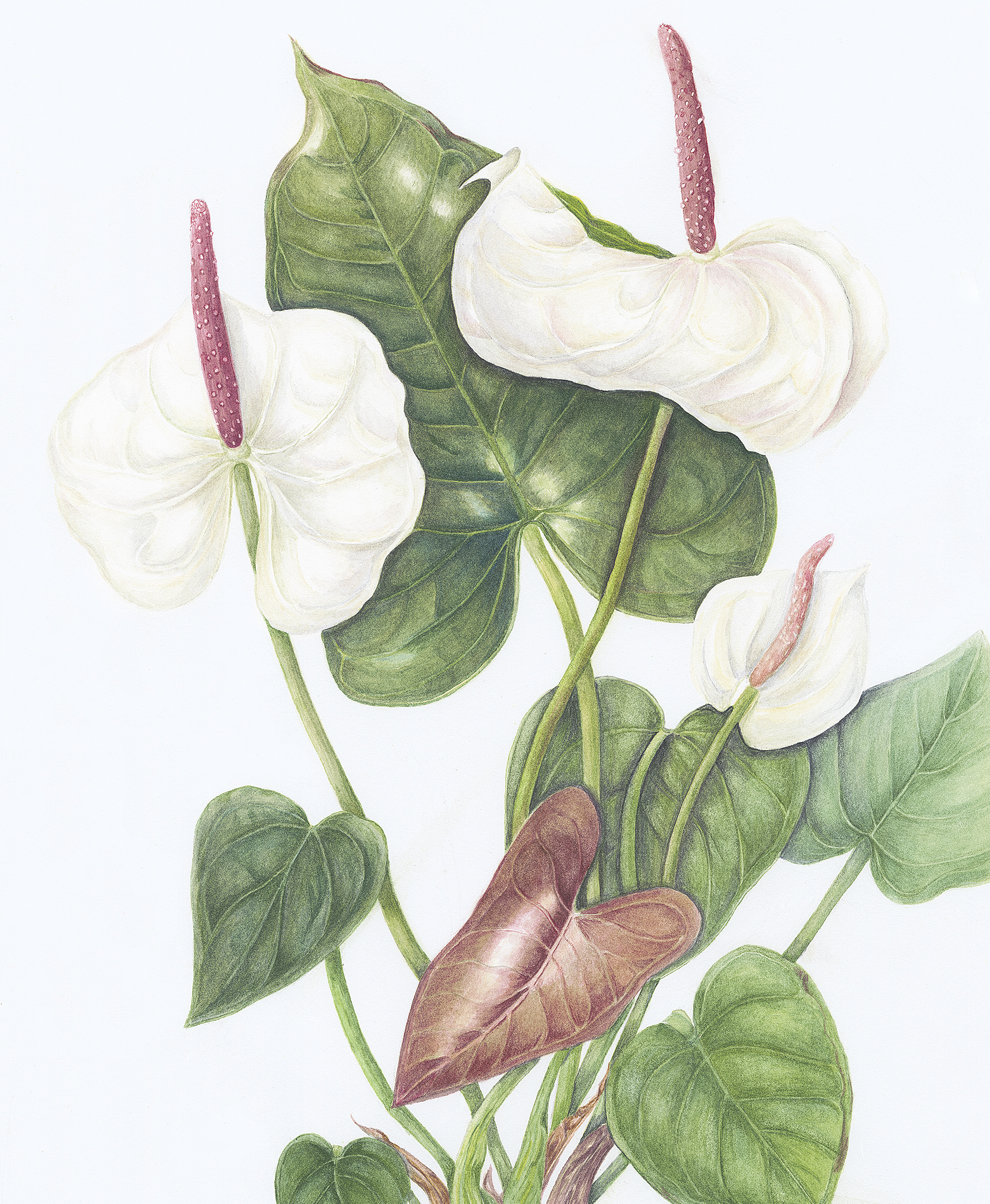
Anthurium
Anthurium Andreaeanum

Black Walnut
Juglans Nigra
Illustration © Pam Gordon

Illustration © Barbara Degregorio

Chenille Plant
Acalypha Hispida
Illustration © Anita Turner

Darwin's orchid
Angraecum sesquipedale
Illustration © Kathy Folino
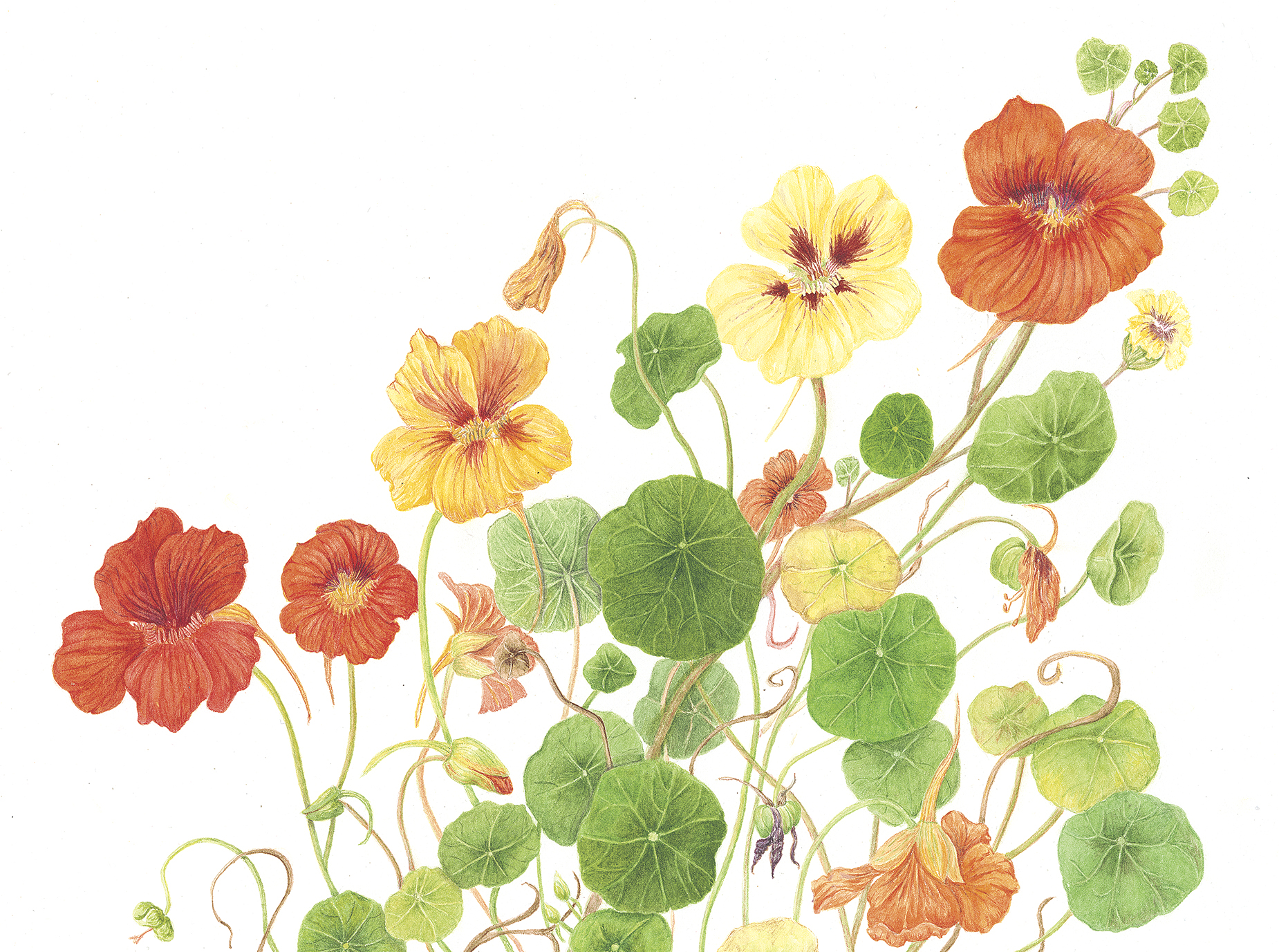
Nasturtium
Tropaeolum majus

Water Hyacinth
Eichhornia crassipes
Illustration © Barbara Degregorio

Powderpuff
Calliandra Haematocephala
Illustration © Barbara Degregorio
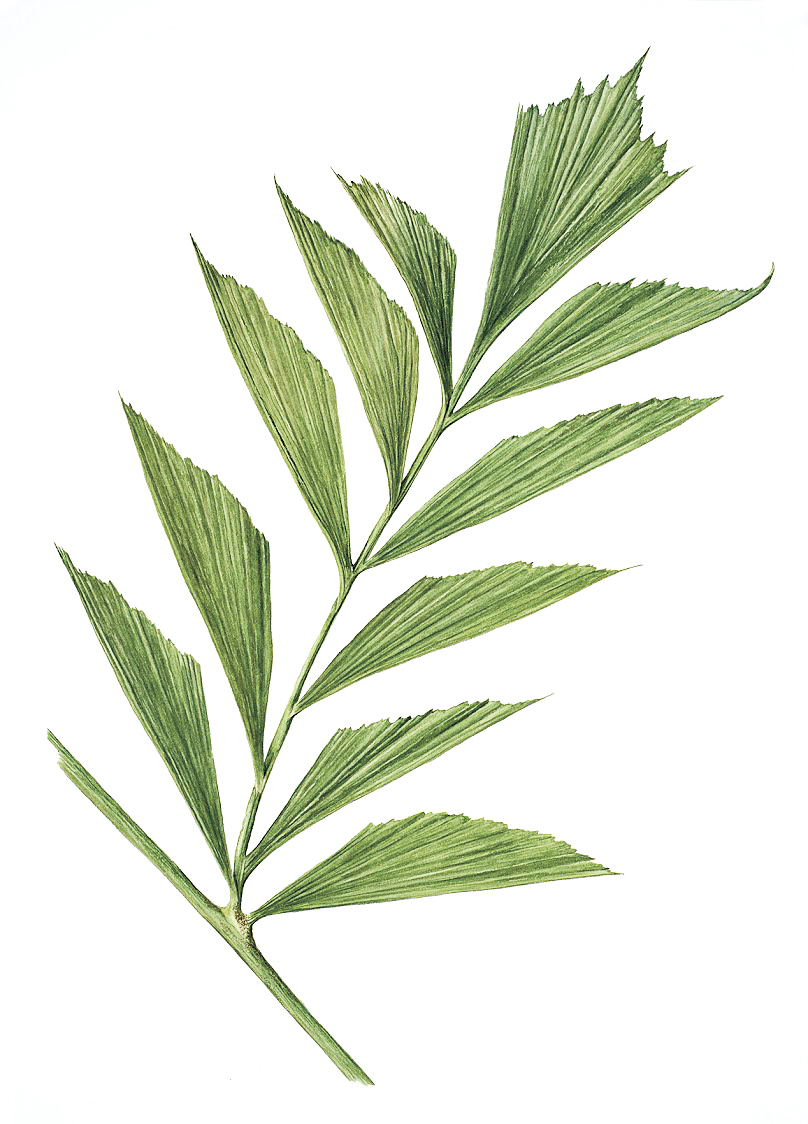
Fishtail Palm
Caryota Urens
Illustration © Nancy Savage
As printing techniques advanced, and new plants came to Europe from Asia in the 16th century, wealthy patrons and botanic gardens commissioned artists to record these exotics in florilegia. Some of them were very detailed catalogs used to sell bulbs and plants.
The collections have been influential from the start. A florilegium by Emanuel Sweerts, a Dutch floral trader, was published in 1612 and pictured some 300 bulbs and 240 flowering plants. It became something of a best seller, reprinted twice, and its index of plant names translated into Latin, German, and French. Sweerts’ work is thought to have contributed to an economic crash in Holland in 1637 fueled by wild speculation in tulip bulbs. Another significant volume, Le Jardin du roy tres chrestien Henri IV, had a more benign effect. Published in 1608 in Paris, it was dedicated to Marie de Medici, who started the fashion for embroidery with floral designs.
The popularity of florilegia continued to grow from the 17th century onward, along with scientific interest in natural history. Simultaneously, aristocratic taste for plant collecting led to remarkable specimen collections like Britain’s Royal Botanic Garden at Kew—where Sarah Roche studied.
“When I was quite little, and I talked as one does with my dad about what I might want to do, I asked him if he knew of a job where I could paint apples and cabbages all day,” she laughs. She completed a degree in graphic illustration. “I loved really knowing about what I painted, and I was interested in medical illustration—but it’s hard to find dead bodies lying around, and it was going to take me another two or three years. I really just wanted to get on with it. My course was very small—eight students per year—and I managed to go and work at Kew when I was still a student, in their orchid herbarium. I began doing commissions for the Royal Horticultural Society, scientific illustrations of plants for gardeners-with-a-capital-G to work with.”
The WCBG Friends’ own florilegium is a multiyear project organized by local certificate holders Nancy Savage and Pamela Gordon. Every artist who receives a certificate is invited to participate. From a list of 44 iconic plants developed by WCBG’s assistant director Gail Kahn, each artist will select one species per year to be the subject of a botanical watercolor. The artists retain copyright and the original work, while WCBG acquires the right to print a professional giclée. Regular exhibits of the florilegium giclées are anticipated—perhaps as early as this fall—and an online gallery of florilegium images will appear on the WCBG website. Cards and bags with the images will likely also be available.
‘It’s appealing because of the intimacy you develop with your plant. … it is the detail of the plant and of the process that informs the beauty of what you create.’
—Deborah Bacon Cassady ’61
Working with Kahn and Kristina Niovi Jones, director of WCBG, Savage, Gordon, and their group came up with project guidelines and a mission—to depict the iconic plants of the greenhouses and the arboretum at Wellesley. It was decided that the people involved would only be those who had completed the certificate program.
The artists got started in late summer 2013, and the work is still in progress. The illustrations on these pages represent some of the completed images; many more remain to be done. “We’ve come to a bit of a slowdown now because of the upcoming construction [to rebuild the greenhouses],” says Savage. “We just love doing the artwork,” she adds. “It’s a great way for us to continue as graduates to have the camaraderie and purpose to go ahead.”
After learning botanical illustration, Savage says, “I couldn’t look around outside without noticing everything in a whole different way. I think everyone who is doing it has a love for it—and getting into the detail of it is part of what we love. It’s very different from doing an abstract painting of a flower. I love the science of it.”
Another Wellesley florilegium artist, Deborah Bacon Cassady ’61, who lives in Ipswich, Mass., says, “I had—during a very checkered career, all legal—done art on the side all along, brush painting and a lot of ceramics. When we moved back [to Massachusetts] I wanted to learn more about watercolor. I was impressed with the fact that I could really learn technique. I took so many classes that I thought I might as well jump through the proper hoops that lead in a logical way to more competence, and earn the certificate.”
Working in scientific detail, she says, was a revelation. “I climbed trees as a kid, and we lived near woods, and I have been interested in plants, and I have been interested in environments. I am not a botanist to the point where I learn all the plants—but you certainly learn the plants you’re painting. It’s appealing because of the botany and the observations, the intimacy you develop with your plant. I really enjoy getting into the zone and painting in this very slow meticulous way. You put on layer after layer, and that’s what makes it so luminous. To the artist, it is the detail of the plant and of the process that informs the beauty of what you create.”
Cassady adds that, despite its emphasis on scientific accuracy, botanical illustration is very much an art form. “In botanical art, you are expressing yourself,” she says. “If I were to do a hellebore and Sarah Roche were to do one, they would look entirely different, but both would be accurate. It’s more subtle than if we were doing more ‘expressive’ things.”
Roche concurs. “This is not a quiet little thing done by Victorian ladies as an accomplishment. It’s recognized and collected as an art form all over the world. You have one foot in art and one foot in science. You pass on botanical information about plants in an artistic way, so the person who looking at it is going to see it for the first time. And you, the artist, are never going to look at things the same way again.”
Gail Kahn says, “There has been a new flowering of this art form in this century.” Happily, the Wellesey florilegium project is part of it.

Eastern White Pine
Pinus Strobus
Illustration © Pam Gordon
Catherine O’Neill Grace, a senior associate editor of Wellesley magazine, sat in on a drawing class with Sarah Roche. The narcissus bulb she drew eventually flowered in the window of the magazine office.
Wellesley florilegium images courtesy of the Friends of Wellesley College Botanic Gardens.




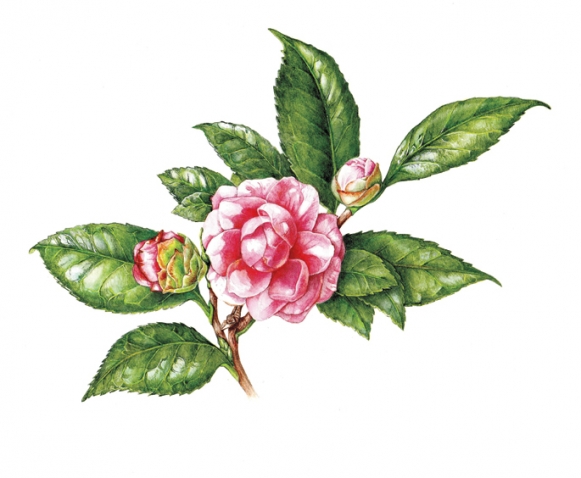











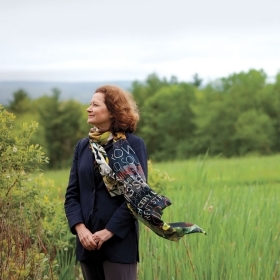
We ask that those who engage in Wellesley magazine's online community act with honesty, integrity, and respect. (Remember the honor code, alums?) We reserve the right to remove comments by impersonators or comments that are not civil and relevant to the subject at hand. By posting here, you are permitting Wellesley magazine to edit and republish your comment in all media. Please remember that all posts are public.